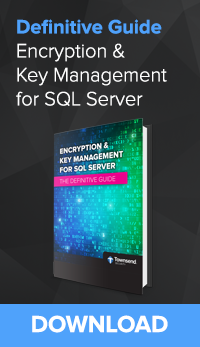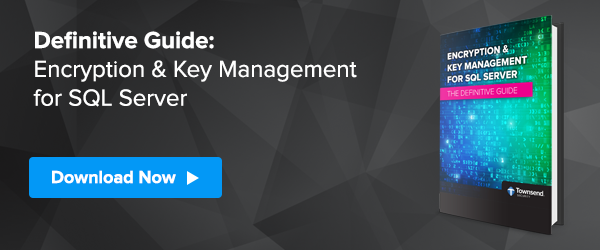Microsoft customers attempting to meet security best practices, compliance regulations, and protection of organization’s digital assets turn to encryption of sensitive data in Microsoft SQL Server databases. The easiest way to encrypt data in SQL Server is through Transparent Data Encryption (TDE) which is a supported feature in SQL Server Enterprise Edition. For a variety of reasons, TDE may not be the optimal solution. Microsoft customers using SQL Server Standard, Web, and Express Editions do not have access to the TDE feature. And even when using SQL Server Enterprise Edition, TDE may not be the best choice for very large databases.
 Let’s look at some approaches to column level encryption in SQL Server. The following discussion assumes that you want to meet encryption key management best practices by storing encryption keys away from the protected data, and retain full and exclusive control of your encryption keys.
Let’s look at some approaches to column level encryption in SQL Server. The following discussion assumes that you want to meet encryption key management best practices by storing encryption keys away from the protected data, and retain full and exclusive control of your encryption keys.
Column Level Encryption (aka Cell Level Encryption)
Starting with the release of SQL Server 2008, all Enterprise editions of the database have supported the Extensible Key Management (EKM) architecture. The EKM architecture allows for two encryption options: Transparent Data Encryption (TDE) and Column Level Encryption (CLE). Cell Level Encryption is the term Microsoft uses for column level encryption. SQL Server Enterprise edition customers automatically have access to column level encryption through the EKM architecture.
Encryption Key Management solution providers can support both TDE and Column Level Encryption through their EKM Provider software. However, not all key management providers support both - some only support TDE encryption. If your key management vendor supports Cell Level Encryption this provides a path to column level encryption in SQL Server Enterprise editions.
Application Layer Encryption
Another approach to column level encryption that works well for SQL Server Standard, Web, and Express editions is to implement encryption and decryption at the application layer. This means that your application performs encryption on a column’s content before inserting or updating the database, and performs decryption on a column’s content after reading a value from the database. Almost all modern application languages support the industry standard AES encryption algorithm. Implementing encryption in languages such as C#, Java, Perl, Python, and other programming languages is now efficient and relatively painless.
The challenge that developers face when implementing encryption at the application layer is the proper protection of encryption keys. Security best practices and compliance regulations require a high level of protection of encryption keys. This is best accomplished through the use of an encryption key management system specifically designed to create, securely store, and manage strong encryption keys. For developers, the primary challenge in a SQL Server encryption project is integrating the application with the key manager. Many vendors of key management systems make this easier by providing Software Development Kits (SDKs) and sample code to help the developer accomplish this task easily.
SQL Views and Triggers with User Defined Functions (UDFs)
Another approach to column level encryption involves the use of SQL Views and Triggers. Leveraging the use of User Defined Functions (UDFs) the database administrator and application developer can implement column level encryption by creating SQL Views over existing tables, then implementing SQL Triggers to invoke user defined functions that retrieve encryption keys and perform encryption and decryption tasks. This approach has the advantage of minimizing the amount of application programming that is required, but does require analysis of the SQL database and the use of User Defined Functions. Database administrators and application developers may be able to leverage the SDKs provided by an encryption key management solution to make this process easier.
SQL Server Always Encrypted
One promising new technology recently implemented by Microsoft is SQL Server Always Encrypted. This feature is new with SQL Server 2016 and can work with any edition of SQL Server. It is a client-side architecture which means that column data is encrypted before it is sent to the database, and decrypted after it is retrieved from the database. While there are many constraints in how you can put and get data from SQL Server, it is a promising new technology that will help some customers protect data at the column level. You can expect to see support for Always Encrypted being announced by encryption key management vendors in the near future.
SQL Server in the Azure Cloud
As Microsoft customers and ISVs move to the Azure cloud they are taking their SQL Server applications with them. And it is very common that they take full implementations of SQL Server into their Azure virtual cloud instances. When SQL Server applications run in a virtual machine in Azure they support the same options for column level encryption as described above. This includes support for Cell Level Encryption through the EKM Provider architecture as well as application layer encryption. As in traditional IT infrastructure the challenge of encryption key management follows you into the Azure cloud. Azure customers should look to their encryption key management vendors to provide guidance on support for their key management solution and SDKs in Azure. Not all key management solutions run in Azure and Azure is not a supported platform for all vendor SDKs.
Azure SQL Database
In the Azure cloud Microsoft offers the SQL Server database as a cloud service. That is, Microsoft hosts the SQL Server database in the cloud and your applications can use this service rather than a full instance of SQL Server in your cloud instance. Unfortunately, Azure SQL Database only supports Transparent Data Encryption through the EKM Provider interface and does not yet support Cell Level Encryption. It also restricts encryption key management to only the Azure Key Vault facility requiring you to share key custody with Microsoft.
Column level encryption at the application layer is fully supported for Azure SQL Database. As in the traditional IT infrastructure your C#, Java, and other applications can encrypt and decrypt sensitive data above the database level. Again, check with your key management solution provider to insure that application level SDKs are supported in the Azure cloud.
AWS Cloud and SQL Server
The Amazon Web Service (AWS) implementation of cloud workloads parallels that of Microsoft Azure. You can deploy a full instance of SQL Server in an AWS EC2 instance and use the features of SQL Server as in traditional IT infrastructure. Amazon also overs a database service called Amazon Relational Database Service, or RDS. The RDS service offers multiple relational databases including SQL Server. As with Azure there is no support for key management solutions other than the Amazon Key Management Service (KMS) requiring a shared implementation of key custody.
As you can see there are many ways to implement column level encryption in SQL Server and use good encryption key management practices. I hope this helps you on our journey to more secure data in SQL Server.
Patrick

